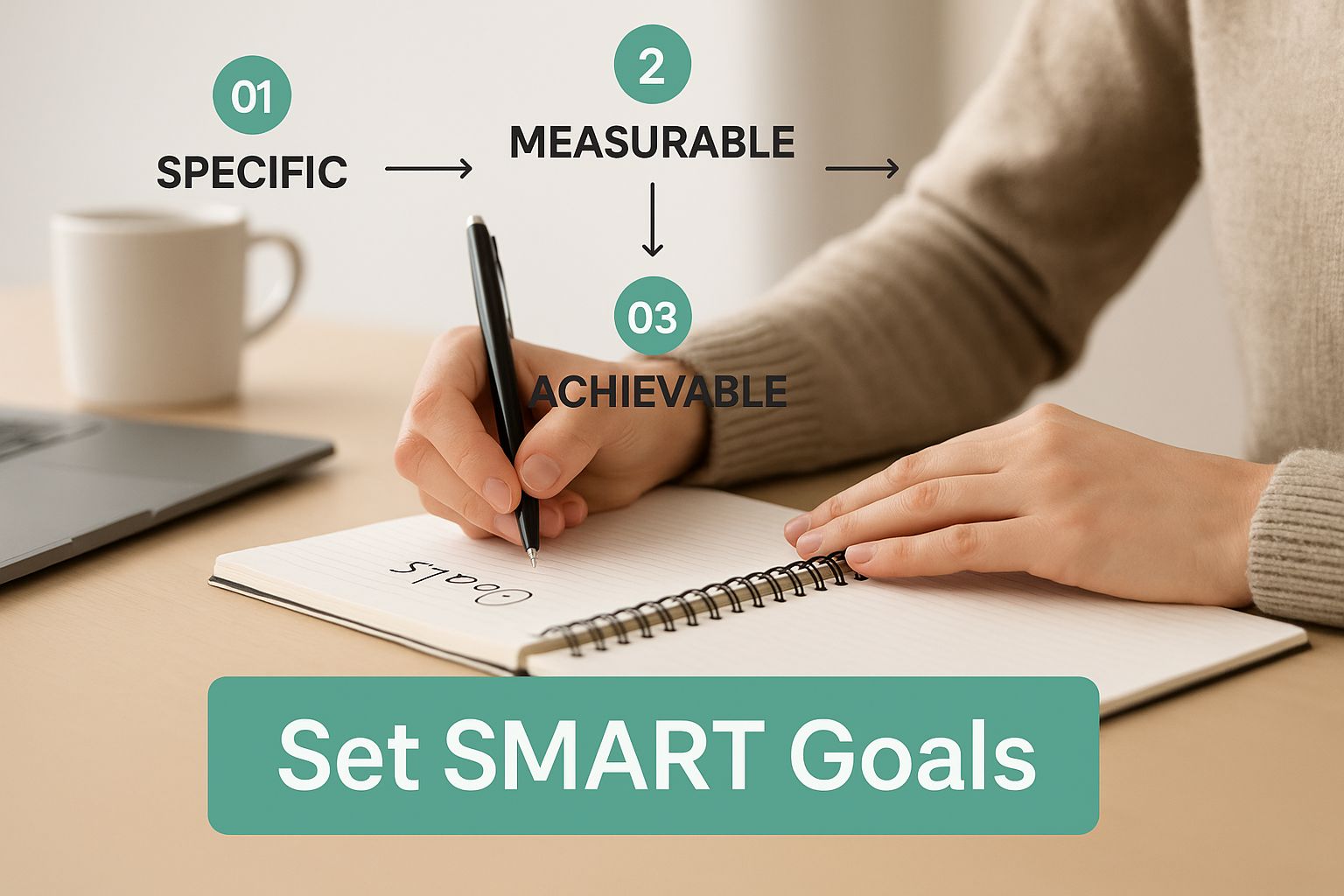
Are you trying to navigate your career without a map? It’s a bit like setting off on a road trip with no destination in mind. You might end up somewhere interesting, but it probably won't be where you hoped to go. A career development plan is your personal roadmap, turning your biggest ambitions into clear, manageable steps.
This guide will show you exactly how to build a plan that works for you. We'll cover:
-
Why a career plan is essential for your growth.
-
How to use our free career development plan template.
-
A step-by-step process for setting meaningful goals.
-
How to keep your plan alive and on track.
Let's get you in the driver's seat of your career.
Why Do You Need a Career Plan?
Let's be honest: thinking about your long-term career can feel overwhelming. "Where do you see yourself in five years?" isn't just a tough interview question; it's something you should be asking yourself. A career plan helps you find the answer.
Think of it less as a stuffy document and more as a living guide for your professional journey. It gives you a sense of direction. Instead of just reacting to opportunities, you can start proactively shaping your career to match your long-term vision.
Find Your Focus and Get Clear on What You Want
A great plan begins with honest self-reflection. You need to look at where you are right now—your skills, your strengths, and the areas where you want to grow. This first step helps you pinpoint what truly drives you and what kind of work makes you feel fulfilled.
This clarity is your superpower. It helps you make smarter decisions, whether that's choosing the right training course or volunteering for a specific project at work. A solid plan is your guide for setting and achieving professional and personal goals that genuinely matter to you.
Once you know what you're aiming for, staying motivated becomes much easier. Your goals will stop feeling like distant daydreams and start looking like real, achievable milestones.
Become an Employee Who Gets Noticed
Managers notice when someone is genuinely invested in their own growth. Having a career development plan shows initiative and a real commitment to improving. It signals that you’re not just there to do a job; you’re there to build a career and make a bigger impact.
This proactive approach can open doors you didn't even know were there. When you sit down with your manager to talk about your plan, you're starting a conversation about your future with the company. It helps them see your potential and figure out how they can support you. This could mean:
-
Getting access to relevant training programnes.
-
Being offered a chance to lead a new project.
-
Receiving valuable mentorship and feedback.
Taking the time to invest in your career is one of the best things you can do for yourself. It shifts you from being a passenger to being the driver of your professional life, making you more adaptable and valuable no matter what the job market throws at you.
This isn’t just good for you; it's smart for business. In the UK, helping staff develop their careers is a huge part of retaining great people. With the average UK salary around £37,400 in 2024, the cost for a company to replace an employee can be 30% to 200% of that figure. Your growth is a sound investment for them, too.
Making the Most of Your Free Career Plan Template

Staring at a blank page can feel intimidating. That’s why our free career development plan template is designed to feel less like a form and more like a guided conversation with yourself. It’s a simple, straightforward tool you can download in different formats to suit how you like to work.
Once you open it, you'll see it’s broken down into key sections. Each one builds on the last, helping you create a clear picture of your career path. Let's walk through it step by step, so you know exactly what to do.
Start With an Honest Look in the Mirror
This is your starting line. You can't map out a route if you don't know where you're standing right now. The first section is all about self-assessment, prompting you to think about your current job and what parts of it you genuinely enjoy (and which parts you don't).
The template then asks you to list your key skills, strengths, and areas for improvement. Honesty is your best friend here; remember, this is for your eyes only. Pinpointing a weakness, whether it’s a fear of public speaking or a gap in technical knowledge, isn't a failure. It’s the first step towards turning it into a strength.
Define Your Long-Term Ambitions
Okay, with a solid grasp of the present, it's time to dream a little. This part of the plan is for your big-picture goals. Where do you truly want to be in the next three to five years? Don't just think about a job title. Think about the kind of work that would make you excited to start your day.
If you’re feeling stuck, try these questions to get your thoughts flowing:
-
What kind of role excites you? Consider the responsibilities, the industry, and the company culture you’d thrive in.
-
What achievements would make you feel proud? Maybe it’s leading a major project, mastering a complex skill, or switching to a new field.
-
What does professional success look like to you? This is personal. It could be a certain salary, a better work-life balance, or becoming a go-to expert.
This vision becomes your North Star, keeping you pointed in the right direction as you work on smaller goals.
A well-defined vision transforms vague hopes into a concrete destination. It gives your smaller, day-to-day efforts a powerful sense of purpose and direction, making it easier to stay motivated when challenges arise.
Figure Out Your Skills Gap
Here’s where the magic happens: connecting where you are with where you want to be. A skills gap analysis simply compares the skills you have with the skills you'll need for your future role. Many people skip this crucial step.
To do this right, you’ll need to do some research. Look up job descriptions for the roles you're aiming for. What skills and qualifications appear again and again? Jot them down. Now, compare that list with your own skillset.
The differences you spot are your development priorities. For instance, if you want to become a senior healthcare professional but you’ve never used specific patient management software, you've just found a gap. This simple exercise turns your career development plan template from a wishlist into an actionable strategy.
Bringing Your Career Development Plan to Life
An empty template is a great start, but now it's time to turn that document into a real, living guide that reflects your personal ambitions. This is where you move from reflection to action.
We'll walk you through creating a compelling five-year vision and pinpointing the exact skills you'll need to get there. By the end, you'll have a solid plan that truly works for you.
Start With an Honest Self-Assessment
Before you can chart a course, you need to know your starting point. The first step in filling out your career development plan template is a candid look in the mirror. This isn’t about being harsh; it’s about being objective.
Think about your current role.
-
What parts of your day give you a real buzz?
-
Which tasks leave you feeling drained?
This simple reflection helps you figure out what genuinely motivates you. Next, take stock of your skills.
-
Strengths: What are you good at? This includes hard skills, like data analysis, and soft skills, like communication. What do colleagues compliment you on?
-
Areas for Improvement: Where do you feel out of your depth? Maybe it’s public speaking or managing a budget. Acknowledging a weak spot is the first step toward making it a strength.
This self-inventory ensures your goals are grounded in reality and built around your unique profile.
An honest self-assessment is your anchor. It stops you from building a plan based on what you think you should want and helps you create one based on who you really are and what you genuinely want to achieve.
Define Your Five-Year Career Vision
With a clear picture of your present, you can look to the future. Where do you honestly see yourself in five years? Think beyond a simple job title. Visualise the work you’ll be doing, the impact you'll have, and the reputation you want to build.
For instance, instead of saying, "I want to be a manager," your vision could be: "In five years, I aim to be leading a small, high-performing early years setting, known for my strategic thinking and my ability to mentor junior colleagues." That level of detail gives you a much clearer target.
If you’re feeling stuck, ask yourself:
-
What kind of problems do I enjoy solving?
-
In what kind of environment do I do my best work?
-
What achievements would make me feel proud?
This long-term vision becomes your professional North Star, guiding your decisions and keeping you motivated.
Formulate SMART Objectives
A vision without a plan is just a daydream. This is where SMART objectives come in, turning big ambitions into smaller, manageable steps. Every goal you set should be:
-
Specific: Clearly state what you want to achieve.
-
Measurable: How will you know when you’ve done it?
-
Achievable: Is the goal realistic for you right now?
-
Relevant: Does this goal help you achieve your five-year vision?
-
Time-bound: When will you get this done?
Let’s bring this to life. A vague goal like "get better at supporting teaching and learning" is hard to act on. A SMART objective sounds like this: "Complete the Level 3 Diploma in Supporting Teaching and Learning (RQF) course within the next six months to improve my classroom support skills." See the difference? It's clear, measurable, and has a deadline.

When you frame your objectives using the SMART criteria, you’re creating a personal checklist for success. It keeps you accountable and makes it easy to track your progress.
To help you get started, this table breaks down the core sections of a career development plan and the key questions to consider.
Core Components of a Career Development Plan
|
Template Section |
Objective |
Key Question to Ask Yourself |
|---|---|---|
|
Self-Assessment |
Understand your current skills, strengths, and weaknesses. |
What do I excel at, and where do I need to grow? |
|
Career Vision |
Define your long-term professional aspirations. |
Where do I want to be in five years? |
|
SMART Goals |
Set clear, measurable, and time-bound objectives. |
What specific goal will move me closer to my vision? |
|
Action Steps |
Outline the practical tasks to achieve each goal. |
What are the exact steps I need to take? |
|
Timeline & Review |
Set deadlines and schedule regular progress checks. |
When will I complete each step, and how often will I review my plan? |
Thinking through these questions for each part of the template will give your plan real structure and purpose.
Connect Your Goals to Actionable Steps
Now, for each SMART objective, break it down into the specific actions you'll take. These are the practical, everyday tasks that will move you forward. Breaking big goals down makes them feel much less daunting.
Let's use our Teaching Assistant diploma goal again. The actionable steps might look like this:
-
Research and choose a training provider within the next two weeks.
-
Request budget approval from my manager by the end of this month.
-
Block out four hours every Saturday to study.
-
Book the final assessment for a date five months from now.
This level of detail transforms your career development plan template into a dynamic to-do list. It also helps you identify the resources you’ll need, whether that's time, money, or support from your boss.
If you’re keen on building leadership skills, a structured program can give you the framework you need. For example, you could explore Stonebridge's TQUK Level 5 Diploma in Leadership and Management for Adult Care (RQF), which provides an excellent foundation for an aspiring leader in this space.
Figuring Out What You Need to Learn (and How to Learn It)
Having a career goal is one thing, but making it happen is another. Your career plan needs a "Skills Gap Analysis" section. This is simply about figuring out what stands between you and your next role.
It's like being a detective. You need to look at the skills you have now and compare them to the skills you’ll need for the job you want. The goal is to build a concrete, step-by-step learning plan to get you there.
Taking Stock of Your Skills
First, you need an honest inventory of what you can do. Let’s get methodical. Pull up job descriptions for the role you’re aiming for. What skills, software, and qualifications keep popping up?
In your plan, make two simple lists:
-
My Current Skills: Put down everything you're good at, from technical skills like advanced Excel to soft skills like client negotiation.
-
Skills I Need: This list comes from your research. What do those job ads say is essential?
Once these are side-by-side, the gaps will be obvious. You might realise specific nursing roles require a particular qualification you don't have. Or maybe you'll see that understanding early years frameworks is now a must-have in your field. This is the foundation of your learning strategy.
As you do this, it’s also a great time to identify transferable skills you've already got. You'd be surprised how many of your abilities can be repositioned for a different role.
Practical Ways to Bridge the Gaps
Spotting a gap is the easy part. Building a bridge to cross it takes a plan. You need learning opportunities that work for you, fit into your life, and move you closer to your goal. The good news is, you have plenty of options.
This is essential. The latest Employer Skills Survey found that 33% of UK employers struggled to fill jobs because of a skills shortage. By focusing on your skills, you're making yourself the solution they're looking for.
Here are a few proven ways to close those gaps:
-
Formal Courses & Certifications: For some things, a formal qualification is the clearest path. It gives you structured learning and a valuable line on your CV. If you're aiming for a new career, we offer a wide range of Access to Higher Education Diplomas in fields like Nursing, Midwifery, Social Work, Business, Computing, and Engineering, perfect for preparing for university. For vocational roles, consider their TQUK Level 3 Diploma for Working in the Early Years Sector (Early Years Educator) or the Level 4 Diploma for the Foot Health Care Practitioner.
-
Learn by Doing: Nothing cements a skill like actually using it. Volunteer for a project at work that pushes you. If you want to get better at public speaking, offer to present at the next team meeting. It’s scary, but it works.
-
Find a Mentor or Coach: This is a game-changer. Find someone who’s already where you want to be and ask for guidance. A good mentor can offer honest feedback and share shortcuts they learned the hard way. Most senior people are happy to help someone showing initiative.
-
Tap into Online Resources: The internet is bursting with learning opportunities. From free YouTube tutorials to in-depth online courses, the resources are endless. At Stonebridge Associated Colleges, we provide 100% online study, making it easy to fit learning around your life. If you need to brush up on core academic skills, our Functional Skills English & Maths Level 2 Including Exams course can be a great starting point.
Remember, your career development plan isn't about becoming a different person overnight. It's about committing to small, steady improvements. Each skill you add is another block you’re using to build the career you want.
Bringing Your Plan to Life and Keeping Track

A plan without action is just a wish list. This is where we shift gears from planning to doing. The real work starts by weaving your career development plan template into your daily, weekly, and monthly routines.
The secret is to break your big SMART goals into small, manageable actions. A goal like, "Get a foot health qualification in six months," can feel overwhelming. But a task like, "Spend two hours on Module 1 this Tuesday," feels completely doable. This approach builds momentum and prevents you from feeling swamped.
Set Up a Rhythm for Regular Check-ins
Your career plan shouldn't be a document you write and then forget. Treat it as a living guide that needs regular attention. Scheduling consistent check-ins is the single most effective way to stay on course.
Think of these as appointments with yourself—a dedicated time to review your progress, celebrate small wins, and adjust your strategy if needed. Life happens and priorities shift, so your plan needs to be flexible.
A simple review schedule makes all the difference:
-
Weekly Review (15 minutes): A quick look at the small tasks you set for the week. Did you get them done? What’s on the list for next week?
-
Monthly Check-in (30 minutes): Step back and look at your progress against your bigger monthly goals. Are you where you need to be?
-
Quarterly Deep Dive (1 hour): This is your bigger, more formal review. How are you tracking towards your main goals for the year? This is a perfect time to share your progress with a manager or mentor.
Treat your career plan like an active project, not a static document. Regular, scheduled reviews are what turn it from a set of forgotten goals into a powerful tool that guides your day-to-day decisions.
Staying Motivated and Rolling with the Punches
Staying motivated over the long haul can be tough. That's why celebrating small milestones is so important. Finished a tricky chapter in a course? Got good feedback on a new skill? Acknowledge it. This positive reinforcement helps keep your energy up.
It's also crucial to be realistic. You'll fall behind sometimes. A project at work might eat up all your time. Don’t see it as a failure. Just adjust your timeline in your next check-in. The aim is consistent progress, not flawless perfection.
This proactive attitude is something employers really value. With studies showing that almost half (48%) of UK workers are thinking about quitting their jobs in 2025, companies are desperate to keep their best people engaged. Your career plan shows you’re invested in your future with them.
Using Tools to Help You on Your Journey
To make tracking your progress feel less like a chore, find tools that suit your style. For some, a notebook is perfect. For others, a digital approach is more effective. If you like managing goals digitally, exploring platforms that offer helpful Notion templates can be a game-changer for keeping your plan organised.
If your goals involve more formal learning, a structured course can be a massive help. For example, if your plan includes a move into a business administration role, an Access to Higher Education Diploma (Business) can give you the specific knowledge you need to make that leap confidently.
Ultimately, turning your plan into reality comes down to making it part of your routine. Break it down, track your progress, and stay flexible. When you do that, your career development plan becomes your most powerful tool for professional growth.
Got Questions About Your Career Plan?
As you finalise your plan, it's normal for questions to pop up. It’s a good sign! It means you’re thinking critically about how to make it work. To give you that final boost of confidence, here are answers to some of the most common questions people ask.
How Often Should I Review My Career Plan?
Your career plan should be a living document, not something you write and forget. You should do an in-depth review at least once a year. A great time for this is right after your annual performance review at work, when feedback is fresh in your mind.
But don't let it gather dust for 12 months. Schedule quick quarterly check-ins to see how you’re tracking against short-term goals and make any small adjustments needed.
Your career plan is like a GPS for your professional life. It needs regular updates to account for new roads, unexpected detours, and even changes in your destination. An outdated plan can lead you down the wrong path.
You'll also want to pull out your plan whenever something significant happens, such as:
-
Finishing a massive project or earning a new certification.
-
A major change in your role or responsibilities.
-
A company reorganisation or a big shift in your industry.
-
Receiving unexpected feedback that makes you rethink things.
Keeping it current is what makes your career development plan template a truly powerful tool.
Should I Share This With My Manager?
Yes, absolutely. Sharing your plan (or at least the relevant parts) with your manager can be one of the smartest things you do. It signals that you’re proactive about your growth, which is exactly what good managers want to see.
The key is to frame the conversation correctly. You aren’t walking in with a list of demands; you’re inviting them to be a partner in your professional journey.
This one conversation can open up many doors. A supportive manager can:
-
Give invaluable feedback on whether your goals are realistic.
-
Flag internal opportunities for training or projects.
-
Champion your case for a training budget.
By bringing them into the loop, you can turn your manager from just a boss into a genuine ally and mentor.
What If My Goals Are Outside My Current Company?
This is a common scenario, so don't feel awkward. Your career plan is for you, first and foremost. It’s perfectly fine if your long-term ambitions point toward a future outside your current organisation.
You obviously don't need to show your manager the part that says, "Leave this job in two years." Instead, focus the conversation on developing transferable skills that benefit both you and them right now.
For instance, if your ultimate goal is to start your own business, you could frame your development goals around:
-
Improving financial skills by helping with budget management.
-
Leading a small project to build team coordination skills.
-
Honing your negotiation abilities in client communication.
This approach shows you as a motivated employee who wants to contribute more, which often leads to more responsibility and better projects—all useful for your future.
What Are the Biggest Mistakes to Avoid?
Creating a career plan is a fantastic move, but a few common pitfalls can make it less effective. Knowing them from the start will help you build something that drives you forward.
The biggest blunders to avoid are:
-
Being too vague: Goals like "get better at IT" are impossible to track. Get specific. Use a framework like SMART to set a clear objective, like "Complete an Access to Higher Education Diploma (Computing) within twelve months to gain foundational IT knowledge."
-
Setting unrealistic expectations: Don't try to reinvent your career in a year. It's a recipe for burnout. Focus on 1-3 key development areas at a time. Slow and steady wins the race.
-
Creating it and forgetting it: A plan is worthless if it just gathers digital dust. Schedule those review sessions in your calendar. Think of it as a guide for action, not a static file.
Steering clear of these mistakes will help you create a plan that is realistic, actionable, and a genuine catalyst for your professional growth.
At Stonebridge Associated Colleges, we believe everyone deserves the chance to build a brighter future. Our flexible subscription-based courses are designed to fit around your life, helping you gain the skills and qualifications you need to achieve your career goals.
By studying with us, you’ll benefit from 100% online study, personalised support from qualified tutors, and the freedom to pause or cancel your subscription at any time. Explore our courses and start your learning journey today.




















